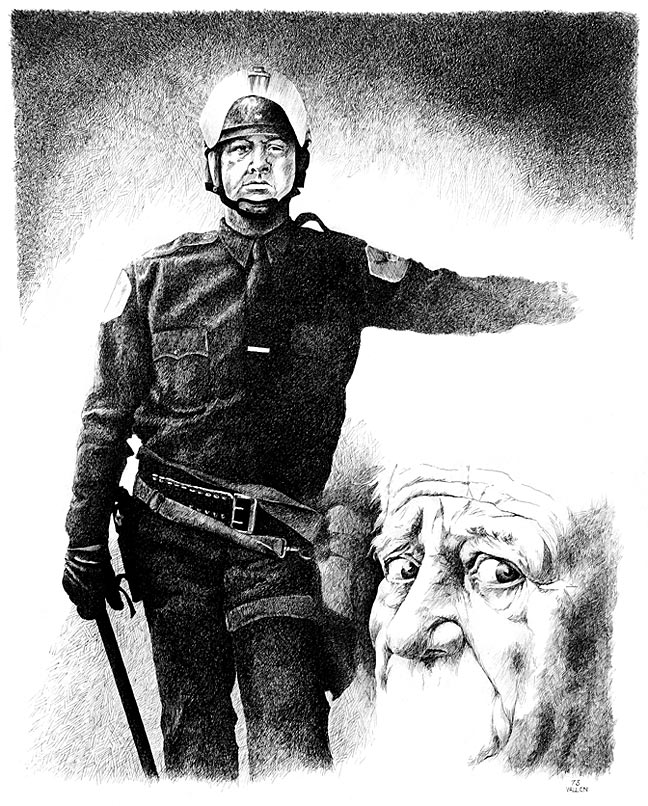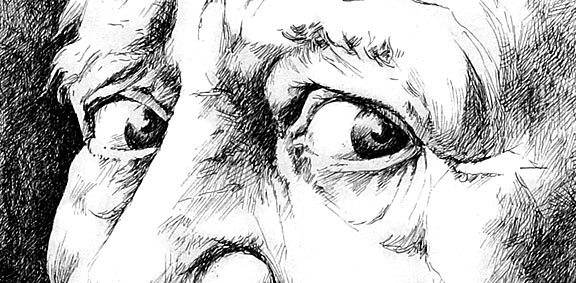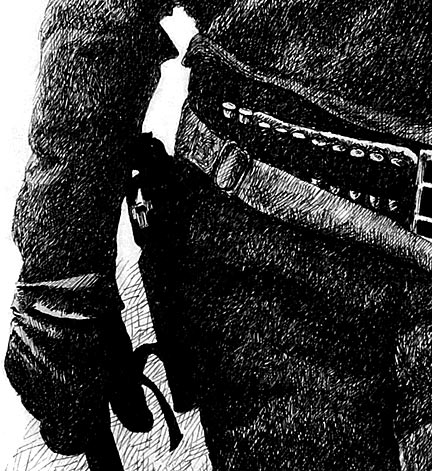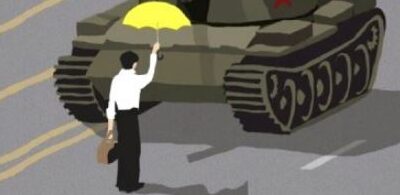Police State
As a nineteen-year-old in 1973, I was captivated by the Austrian painter, Oskar Kokoschka (1886-1980). At the time I was enthralled by the German Expressionist artists who opposed the rot of the German ruling class in the post World War I period. I saw parallels between the life and times of those artists and my own chaotic age. When I read that Kokoschka became known as a young art student in Vienna for his disquieting paintings, earning the name of Oberwildling (meaning “top savage” or “maniac”), I felt a certain kinship with him.

In 1973 I created a drawing in my student sketchbook that was meant purely as an exercise; I never intended to show the sketch to anyone. Considering our tenuous collective future, I think it is important to show, and explain the artwork. I made the freehand drawing with a “rapidograph” technical pen, a tool I used often in those days. Symbolic of mute terror, the angst ridden face in the ink drawing was left without a mouth. A wordless homage to the Viennese savage, the face was loosely based on a photo of Kokoschka by Danish photographer Erling Mandelmann. But Kokoschka and his fellow Expressionists were not the only thing on my mind during those days.

The Cold War was at its height and Richard M. Nixon was serving his first term as president. He had expanded the unpopular war in Vietnam with the massive aerial bombing of neighboring Laos and Cambodia (1969-1973). That campaign, kept secret from the US Congress and the American people, dropped more bombs on Laos than the US managed to drop on Nazi Germany and Imperial Japan during WWII. The 1970 US invasion of Cambodia unleashed a nation-wide antiwar student strike in the US that culminated with National Guard troops killing four students and wounding 9 others at Kent State University on May 4, 1970.
A feeling of doom was descending upon my generation, the war appeared to be endless and a police state seemed to loom large in our future.
Then came the May 1972 break-in at the Democratic National Committee headquarters at the Washington, DC Watergate hotel. The burglary was conducted by operatives of the Nixon administration’s Committee to Re-elect the President. Their mission was to bug the office and steal documents, using the intelligence to help defeat the Democrats in the 1972 election. It was all part of Nixon’s despotic toolbox, like his COINTELPRO program of repression aimed at political opponents in the U.S.
In November of 1972 I was traveling in Italy when the news was announced that Nixon had been re-elected by a “landslide.” I contemplated the implications of the report while standing inside the ancient Colosseum in Rome. Surveying the arena where gladiatorial combat and the burning of Christians once pleased the citizens of ancient Roman, the idea that little had changed since the days of Caligula swept over me. 1973 brought no relief, and events led me to make the pen and ink drawing shown in this post.
Since Nixon was forced out of office in 1974 to avoid impeachment, a number of US leaders have come and gone, but I was wrong about one thing, there really could be worse leaders than Richard Milhous Nixon.

Our current Caligula signed the National Defense Authorization Act (NDAA), which allows for the “indefinite detention of American citizens without due process at the discretion of the President.”
In other words, goodbye habeas corpus.
It has been revealed that Caligula personally draws up “kill lists” with his Praetorian Guard during “Terror Tuesday” meetings. Those placed on the list then become targets for the Hellfire missiles fired by Caesar’s predator drones.
It is a shame more innocent bystanders are killed in those attacks than are barbarians, but that is the cost of imperium. The Most Noble Caesar also has the entire population of the empire under intense surveillance, because of course, he loves us so.
As for me, I am still drawing pictures in my private sketchbooks that rail against Caesar, his police state legions, and his imperial wars. Perhaps in 40 years those drawings will be shared with the public… provided that democratic governance exists.


